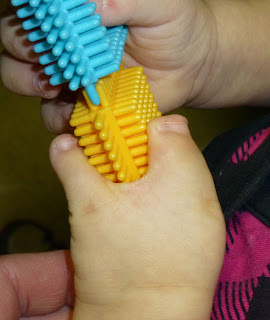Central deficiency (cleft hand) is classically as I have shown in previous blogs. http://congenitalhand.wustl.edu/2012/05/cleft-hand-surgery.html We have previously published our experience with the classic central deficiency, that is the hand with a limited thumb- index web space, 3 fingers (index, ring, and small finger), and a large cleft http://www.ncbi.nlm.nih.gov/pubmed/18984341
However, there are many different varieties of cleft hand, as previously classified by Dr Ogino in Japan and Dr. Manske here in St. Louis. Dr Ogino’s classification is based on how many digits are missing and Dr Manske’s classification, http://www.ncbi.nlm.nih.gov/pubmed/7594304 is based on the thumb web space- which is important for function. If the thumb- index web space is limited, the overall hand function will be markedly limited. The child will struggle to grab large objects but also will find it difficult to manipulate smaller ones.
With less common types of central deficiency, surgery is sometimes completely avoided or may be minimized. Consider these 2 examples.
1)
 |
| A conjoined thumb with pinky finger in cleft hand. Note the small web space. |
 |
| Cleft hand with difficulty grasping large objects. The thumb is not positioned to best grasp or pinched (i.e., not opposed to fingers) |
 |
| Cleft hand xray. |
We will likely help this child’s function with 2 procedures, one to slightly deepen the web space to allow larger object grasp and a second to rotate and reposition the thumb in a position to better pinch and grasp against the pinky finger.
2) Consider the next child with a very similar hand. A merged thumb and a single other digit. However, the difference is that the
cleft is deeper allowing the child to grasp larger objects and the thumb is opposed. Look how the child can grasp with the thumb against the finger with a pen and with cheerios. Surgery is unlikely to help. Additionally, one might consider narrowing the thumb but I would argue against that procedure as I think it would hurt function and would be unlikely to help appearance.
 |
| A second child with similar cleft hand. |
 |
| Cleft hand with a well- opposed thumb easily manipulating a pen. |
 |
| Also able to easily manipulate a cheerio. Note the position of the thumb against small finger. |






My son has this deformity. I have no one to relate to. Is there any websites available to speak with other parents and children about their situation? Feedback would be greatly appreciated.
Please see the Links from my blog. All are reasonable sites to explore and many have family forums.
This comment has been removed by the author.
How do you do?
I live in Japan.
My child has the same hand as the child of the 2nd photograph of this page.
However, two bones were contained in the thick thumb.
How many bones are there in this child's thumb?
Hi Charles,
We are living in Moscow. Our daughter has a similar problem as shown in your Figures. Currently, she is 13 months old. I am wondering if we can send you the photo and x-ray image for review? We would like to understand what kind of surgery can be recommended in our case.
Thanks,
Oleg
I would be happy to try and help with some general thoughts. Feel free to email at congenitalhand@wudosis.wustl.edu
We often see patterns in even these rare anomalies. This child (see x-ray although it is difficult to interpret) also has 2 sets of bones in the thumb. This represents a merging of the index finger and the thumb most likely. I do not feel that separating these digits or narrowing the thumb is likely to be helpful. It might make the thumb look smaller but is unlikely to help function.
Hi Charles,
This is a very helpful post. I found it when searching on Google.
My neighbor's son has a hand like this. He is very glad to read this post. Thank so much ! Charlotte
Thank so much !